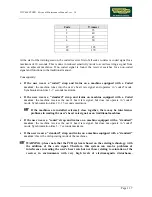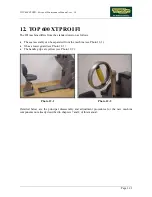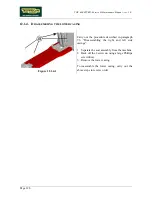
TOP 600 XTPRO: Service & Maintenance Manual - rev. 2.0
Page 11.4
Sensitivity is reduced by soldering a resistor in parallel with the coil. Normally, the receiver already
has a 15 KOhm resistor mounted in parallel with the coil, however it is advisable to check for its
presence.
The following table shows the nominal values of reception distance based on the value of the
resistor soldered on the coil:
RESISTANCE
(Ohm)
DISTANCE
(cm)
15K 89
13K 88
11K 87
9K1 85
6K8 84
5K1 81
3K 74
2K 69
1K 57
Please note that these are only nominal values. The actual reduction in sensitivity must be verified
experimentally, taking great care not to excessively reduce the reception distance.
WARNING: if there is already a 15 KOhm resistor mounted in parallel with the coil,
note that adding another resistor in parallel will produce a total resistance value
equivalent to the parallel combination of the added resistor and the existing 15 KOhm
resistor.
11.1.4. M
ECHANICAL VIBRATIONS
Mechanical vibrations may cause slight shifting of the coil, giving rise to transient impulses. If
these transients occur only occasionally they can be easily filtered by SW. However, if the
mechanical vibrations are periodic, they can produce periodic pulses which may be interpreted as
correct heart rate values.
To eliminate or reduce the effects of vibration, house the receiver between the foam pads in such a
way that any vibrations are correctly damped.
11.1.5. P
OSITION OF THE RECEIVER
Carefully position the receiver according to the specifications below:
•
the coil must be directed toward the user;
•
the coil must be positioned well away (even a few centimeters) from the LEDs;
•
the cable must be folded immediately after the connection on the receiver, so that it does not
pass near the coil;
•
the receiver must be directed in such a way that its axis of reception is parallel to that of the
transmitter, as shown in the figure below:
Summary of Contents for Top 600 XTPRO
Page 1: ...SERVICE MAINTENANCE MANUAL REV 2 0...
Page 2: ......
Page 4: ......
Page 8: ...TOP 600 XTPRO Service Maintenance Manual rev 2 0 Page iv Page intentionally left blank...
Page 18: ...TOP 600 XTPRO Service Maintenance Manual rev 2 0 Page 2 8 Page intentionally left blank...
Page 26: ...TOP 600 XTPRO Service Maintenance Manual rev 2 0 Page 4 2 Page intentionally left blank...
Page 58: ...TOP 600 XTPRO Service Maintenance Manual rev 2 0 Page 7 18 Page intentionally left blank...
Page 70: ...TOP 600 XTPRO Service Maintenance Manual rev 2 0 Page 9 6 Page intentionally left blank...
Page 82: ......
Page 83: ...TOP 600 XTPRO Service Maintenance Manual rev 2 0 Page intentionally left blank Page 11 1...
Page 84: ......
Page 93: ......













































